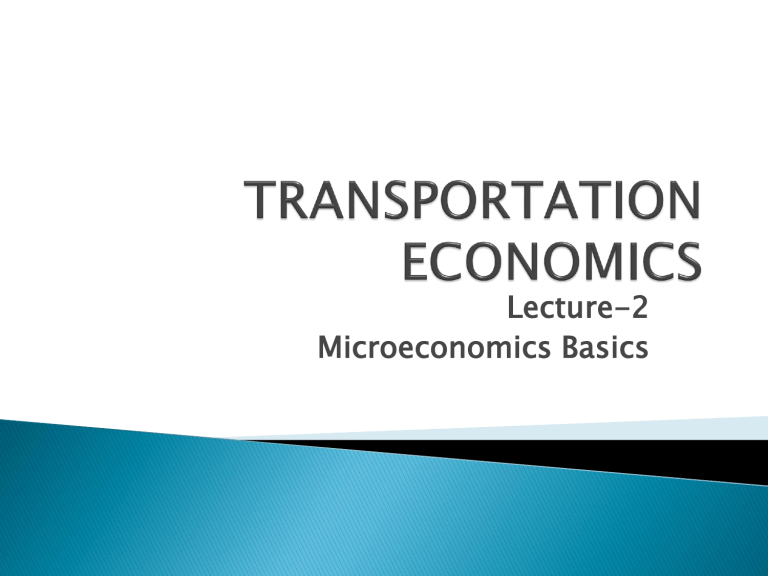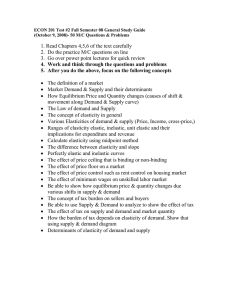
Lecture-2 Microeconomics Basics Same supply and demand principles… ◦ … well, almost! Choices between non-similar goods ◦ Mode choice Network effects ◦ Transportation network is composed of entities Complementary Subway and AirTrain Substitute Air vs. HSR (for certain distances) Else? ◦ Externalities What about the Equilibrium Price? ◦ Transportation costs Fixed (infrastructure) costs: Do not vary with output Variable (operating) costs: Vary based on the level of output Modes Fixed / Capital Costs Operating Costs Land, Construction, Rail or highway Maintenance, Labor, Fuel Rolling Stock Pipeline Land, Construction Maintenance, Energy Land, Field & Terminal Air Maintenance, Fuel, Labor Construction, Aircraft Land for Port Terminals, Maritime Cargo Handling Maintenance, Labor, Fuel Equipment, Ships Source: The Geography of Transport Systems Other costs (social, environmental etc.) Estimated Highway External Crash Costs (Cents Per Vehicle Mile) (FHWA) Rural Highways All Highways High Med. 9.68 3.15 1.76 4.03 1.28 0.78 6.02 1.94 1.13 Pickup & Van 10.21 3.31 1.75 4.05 1.27 0.74 6.70 2.15 1.17 Buses 14.15 4.40 2.36 6.25 1.89 1.08 9.55 2.94 1.62 5.97 2.00 0.97 2.21 0.71 0.40 3.90 1.29 0.65 6.90 2.20 1.02 3.67 1.16 0.56 5.65 1.79 0.84 9.52 3.09 1.68 3.98 1.26 0.76 6.12 1.97 1.11 Automobile Single Unit Trucks Combination Trucks All Vehicles Low Urban Highways High Med. Low High Source: TDM Encyclopedia Med. Low In general: percentage change of one variable vs. percentage change in another variable Price elasticity of Demand: Change in demand quantity vs. change in price for single commodity Income Elasticity of Demand??? Price elasticity of Supply: change of supplied quantity vs. change in price Cross-price elasticity of demand: change of demand quantity of a good vs. price change of another good Substitutes? Pepsi and Coke Necessity or luxury? Bread vs. Ipad The market Food vs. electronics Time Horizon Sudden increase in oil price vs. demand Elasticity = E = E=0 ? E=-1 ? E=-∞ ? % change in demand % change in price The amount paid by buyers and received by sellers. Total Revenue=P × Q, the price of the good times the quantity of the good sold ◦ When demand is inelastic (a price elasticity less than 1), price and total revenue move in the same direction. ◦ When demand is elastic (a price elasticity greater than 1), price and total revenue move in opposite directions. ◦ If demand is unit elastic (a price elasticity exactly equal to 1), total revenue remains constant when the price changes. Source: Mankiw, 2007 Source: Wikipedia Total cost f(Quantity) Average cost Total cost/Quantity Average fixed cost ?? Average variable cost ?? Marginal Cost Change in total cost per additional unit production 𝑀𝐶 = ∆𝑇𝐶 ∆𝑄





